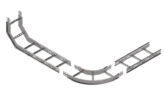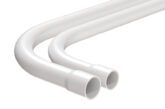
In this bulletin the ECA’s technical team looks at the requirements for the IP rating of trunking.
The trunking currently being used in electrical installations typically has an International Protection (IP) rating (otherwise known as Ingress Protection Rating) of IP3X where joints have been fabricated on-site. This has been used for many years and has proven suitable for general use, provided it’s been installed in the correct manner and the IP3X requirement is maintained. The IP3X required is as follows:
IP3X
This prevents solid objects which are greater than 2.5mm from penetrating the enclosure and access is only by the use of a tool. The object probe shouldn’t be able to penetrate the enclosure at all. Both manufacturer’s joints and site fabricated joints in the trunking and lid must meet this criteria.
However, BS 7671:2008 Amendment 1:2011 introduced a new requirement for trunking to meet which caused much confusion within the industry, and this confusion continues to this day.
Regulation 521.10.1 states: Non-sheathed cables for fixed wiring shall be enclosed in conduit, ducting or trunking. This requirement does not apply to a protective conductor complying with Section 543. Non-sheathed cables are permitted if the cable trunking system provides at least the degree of protection IPXXD or IP4X, and if the cover can only be removed by means of a tool or a deliberate action.
NOTE: For a trunking system to meet IP4X requirements, IP4X trunking and related accessories would need to be installed. If a system includes site-fabricated joints the installer must confirm the completed item meets at least the degree of protection IPXXD.
The key elements here are understanding what the requirements are and ensuring that the installation meets one of the options, namely IPXXD or IP4X.
IPXXD:
For this degree of protection, only the third letter ‘D’ is relevant. The letter ‘X’ signifies that the first and second letter protection levels are not specified. BS EN 60529:1992 + A2:2013 states the requirement for ‘D’ as the degree of protection required for protection of persons against access to ‘hazardous parts’. An access probe having a maximum diameter of 1mm and maximum length of 100mm, when inserted into any gap or joint within an enclosure with an applied force of 1 Newton, must not make contact with ‘hazardous parts’.
Hazardous Part (D)
The definition of ‘hazardous part’ from BS EN 60529:1992 + A2:2013 is: A part that is hazardous to approach or touch.
For example, in electrical terms, a bare live conductor is clearly a ‘hazardous part’. However, an insulated live conductor (even single insulated) is not, as the insulation provides the necessary ‘basic protection’.
In this context, a trunking system containing single insulated conductors (cables) is only required to protect the cable insulation from the risk of mechanical damage, which may arise from an external influence. Once the insulation has suffered damage by such an action and
exposes the conductor of the cable, the cable then becomes a ‘hazardous part’. The ‘hazardous part’ in this context is an exposed live conductor.
Therefore, this degree of protection in trunking systems is necessary to prevent the risk from mechanical damage to cable insulation from an external influence, rather than for shock protection. It’s clear from this that IP3X trunking could be installed in a manner that ensured the IPXXD requirement is met without need for on-site testing with a probe.
IP4X
For this degree of protection only the first numeral is relevant, which indicates the level of protection against ingress of solid foreign objects. An access probe with a maximum diameter of 1mm mustn’t penetrate and enter the enclosure. Therefore, the ‘hazardous part’ issue is somewhat secondary and makes this requirement far more onerous than the requirement for IPXXD. In practice it means that joints in trunking systems are likely to need supplementary barrier plates fitted over the joints in the trunking and the lid, or workmanship should be sufficiently good so that no joints wider than 1mm exist.
Application example
The client may specify the IP4X enhanced level of ingress protection. Where such an enhancement isn’t specified, the installer still has the option of using IPXXD. You should bear in mind that the cost of IP4X trunking systems are likely to exceed those of IP3X or IPXXD systems.
In summary, although the Regulation formalizes limitations on access to trunking systems, these limitations have generally been achieved in the past by good workmanship. Continued good workmanship and practices will ensure that this continues.
However, it’s worth noting in any specification or design that, where site manufactured trunking joints are to be fabricated, they may not easily meet the requirement of IP4X but more likely IPXXD.
For further information and assistance, or to find out more about ECA membership you can visit: www.eca.co.uk








